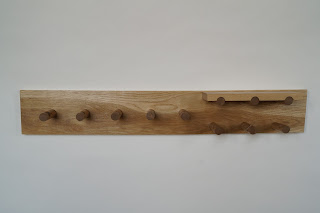A lot of the wood I
obtain from my local wood yard are small manageable pieces (offcuts sometimes)
because I as yet don’t have the capacity for too large a stock of wood, so I tend
to purchase the smaller sections of wood that I can make small items out of and
leave the bigger sections for my fledgling commission work. The trouble with
these smaller offcut sections I buy is that what there is, is what you get. So
you can’t really specify the size you want- it’s that size or you buy a massive
piece of wood and cut it down- which I find people shy away from. So with this in mind I wanted to turn my
attention to the redundant sections of wood that are fresh from the table saw,
that are cut off to obtain the bigger sections (the waste material). Uneven
lengths, roughly cut, untreated and just ready to sell as they are, ungraded
etc etc. I thought why can’t the
consumer have a closer connection to the wood, and understand/know where the
wood has come from and what it goes through to get to them? Why can’t I show that the discarded offcuts of
wood can still be used but also worked very minimally to produce functional,
unique pieces of design- that are just as attractive as the straight edged,
perfect sections of wood? -and retain their origins/routes back to the woodyard/human
interaction they had to get their shape. A lot of questions! So I decided to
design and make a product that used these rough redundant offcuts of wood and
adhere to a minimal interference ethic to produce a coat rack.
So basically the
wood of this design (English oak) specifically the back plate (which shows some
lovely heart wood graining) and the shelf are as they were, from the wood yard
floor. I haven’t cut or treated the back plate; all I did was sand it and oil
it. So the ends are still painted from the wood yard (which gives a unique identity
to it) the edges and end faces are not straight, so viewed head on it’s got a
natural bow along the length. It’s untouched as much as possible by me, to give
that connection to the user of where it’s from and demonstrate that not all
materials have to be planed, sawn and treated to strip the identity from it to
obtain a perceived aesthetic.
Why can’t the rough
edges, half painted ends be seen as an attractive individual quirkiness,
appealing in a way?
So once I had
prepared this piece of wood which was randomly bought by me from the wood yard
as I liked its appearance and uniqueness, I set about taking one of my previous
ideas for a coat rack and adapting it to a larger scale. And incorporate a
unique feature into it by way of an adjustable shelf that lies across the screw
in pegs. This gives the design a great added functional element to display or
place items that are needed close to hand, keys, letters, phone etc. So like my
previous coat rack design this gives the user options that other coat racks
don’t have.
I simply drilled
eleven hols along the woods length, placing six together at one to maximise the
storage space along this predetermined length. Then using my great little wood
threading tool I made 11 pegs (the only part of the design that has had
industrial machine contact, if time and resources allowed I would have turned
this pegs by hand) and put the screw thread feature on each of them so the user
can customise the rack to their individual requirements and place the pegs and
hence the shelf where they want. Lastly the shelf, which again was made from an
offcut, was routed to achieve 3 slots in it so it can attach to the pegs
anywhere along the length. The whole design is finished in Danish oil to
protect the wood and enhance that lovely heart section. The unit can then be
secured to a wall by means of simply using screws that are concealed behind the
screw in pegs.
The result of all
this…a very simple concept which importantly uses very simple construction
methods and minimal involvement by me, which was one the original
requirements/challenges of this project. So on first view this design looks
unfinished, messy, untouched in away, and maybe of poor quality. But by being
this way visually, it allows the user to understand where the wood is from and
what it goes through, it demonstrates that you haven’t got to disguise the
journey of the wood, from tree to table so to speak and it allows a closer
connection and understanding of what goes into the production/manufacture of
wood and wood based products. Hopefully changing people’s ideals and cementing
the notion that every piece of wood can be attractive and used purposefully and
still be just as desirable as a machined piece of design. Which could be seen
as being stripped of its personality and history? Not allowed to tell the story
of its industrial life.
Be sure to follow me on twitter, instagram and Google plus.
All links to these can be found on my Google plus page.









Brilliant design, changeable and elegant, good one.
ReplyDeleteNice simple
ReplyDelete